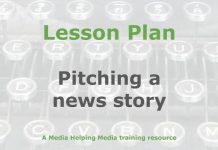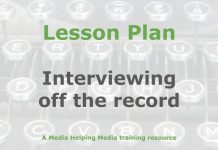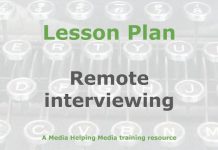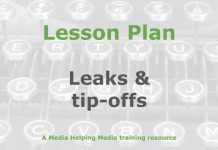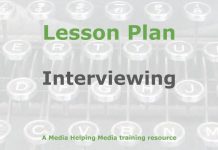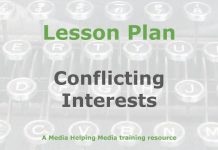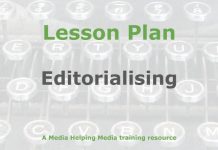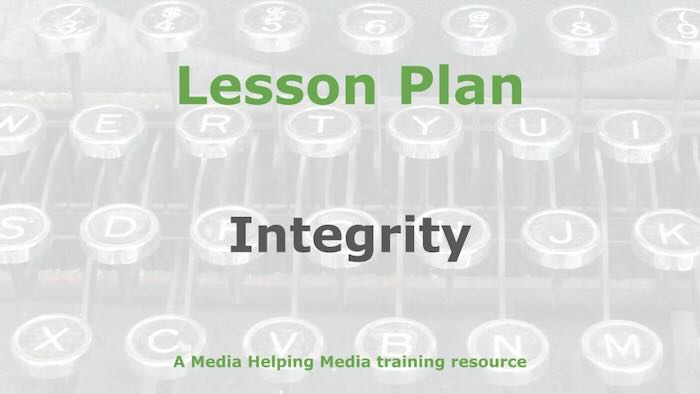 This lesson plan teaches students the importance of maintaining integrity in all their dealing in order to investigate issues thoroughly and truthfully without being influenced by external pressures.
This lesson plan teaches students the importance of maintaining integrity in all their dealing in order to investigate issues thoroughly and truthfully without being influenced by external pressures.
It’s based on the article ‘Integrity and journalism‘ which is published on Media Helping Media. We recommend you read the article before adapting this lesson plan for your own purposes.
Learning objective
Students will evaluate the role of integrity in journalism by identifying and analysing scenarios where journalistic integrity is challenged. They will also assess the impact of external pressures on journalistic decision-making and propose strategies to maintain integrity.
- Student-facing objective: By the end of this lesson the student will be able to identify situations where a journalist’s integrity might be tested and suggest ways to stay truthful and unbiased.
- Standards: Students will learn about how integrity in journalism empowers them to investigate issues thoroughly and truthfully without being influenced by external pressures.
Learning activities
Warm-up
- Begin with a brief discussion on the concept of integrity. Ask students to share what they understand by the term and how it applies in everyday life. Transition to journalism by posing the question: “Why is integrity crucial for journalists?”
- Next, present a short, hypothetical scenario: A journalist receives a gift from a company they are reporting on. Ask students to consider: “What should the journalist do, and why?” Encourage students to think about potential conflicts of interest and the importance of maintaining impartiality.
- Conclude by summarising the main points from the discussion, emphasising the role of integrity in ensuring truthful and unbiased reporting. This sets the stage for deeper exploration in the lesson.
Direct instruction
- Conceptual understanding: Introduce the concept of journalistic integrity by discussing real-world examples where integrity was either upheld or compromised. Use a case study of a well-known journalist who faced ethical dilemmas. Describe the situation and ask students to identify the integrity issues involved. Discuss the consequences of the journalist’s actions on public trust and the news organisation’s credibility.
- Procedural skills and fluency: Explain the procedures journalists should follow to maintain integrity. Outline issues such as:
- Avoiding conflicts of interest.
- Ensuring editorial independence.
- Declaring any potential biases.
- Scenario: Provide a hypothetical scenario where a journalist must decide whether to accept a free trip to cover a story. Ask students to outline the steps the journalist should take to maintain integrity, using the practices discussed.
- Application: Present a scenario where students must apply their understanding of journalistic integrity. For example, a journalist is offered exclusive access to a high-profile event in exchange for favourable coverage. Ask students to:
- Identify the ethical issues.
- Propose a course of action that upholds integrity.
- Justify their decisions based on the principles discussed.
- Encourage students to consider the broader implications of their decisions on public perception and trust in journalism.
Guided practice
Think, Pair, Share: Facilitate a discussion on a scenario where a journalist’s integrity is tested.
- Think: Present a scenario where a journalist is offered a gift in exchange for favourable coverage. Ask students to individually think about the ethical issues and potential actions the journalist could take.
- Pair: Have students pair up to discuss their thoughts. Encourage them to consider the implications of accepting the gift and how it might affect the journalist’s credibility and the news organisation’s reputation.
- Share: Invite pairs to share their discussions with the class. Highlight different perspectives and solutions, emphasising the importance of maintaining integrity.
- Collect and display: As students share, write the main points and ethical considerations on the board. Organise these into categories such as “potential conflicts,” “actions to maintain integrity,” and “consequences.”
- Connect: Conclude by connecting the discussion to the broader principles of journalistic integrity. Reinforce the idea that integrity is crucial for maintaining public trust and ensuring unbiased reporting.
Independent practice
- Scenario analysis: Provide students with a set of brief scenarios where journalistic integrity is challenged. Examples might include receiving gifts, facing pressure from advertisers, or dealing with conflicts of interest. Ask students to analyse each scenario and write a brief response on how they would handle the situation to maintain integrity.
- Reflection exercise: Have students reflect on a recent news story they have read or watched. Ask them to evaluate the story for potential biases or conflicts of interest. They should consider whether the journalist maintained integrity and how they might have approached the story differently.
- Role-playing: Assign students roles as journalists, editors, or external influencers. Present a situation where integrity is at stake, such as a high-profile interview with potential for bias. Students must navigate the scenario, making decisions that uphold journalistic integrity. Afterward, have them discuss the challenges they faced and the strategies they used.
- Peer review: Students exchange their scenario analyses or reflection exercises with a partner. They provide feedback on each other’s work, focusing on the identification of ethical issues and the proposed solutions. Encourage constructive criticism and discussion on alternative approaches to maintaining integrity.
Assignment
Ask students to answer these questions:
- What is one main principle of journalistic integrity you learned today?
- How can a journalist maintain integrity when faced with external pressures?
- What’s one question you still have from today’s lesson?
Here are some suggested answers:
- Suggested answer to Question 1: Journalists should avoid conflicts of interest to maintain integrity.
- Suggested answer to Question 2: A journalist can maintain integrity by ensuring editorial independence and declaring potential biases.
Teacher resources
Differentiation guide
- Advanced learners: Encourage deeper analysis by having them research and present on historical cases where journalistic integrity was compromised. Challenge them to propose alternative actions that could have upheld integrity.
- Striving learners: Simplify scenarios and provide structured guidance. Use role-playing to help them visualise ethical dilemmas. Offer sentence starters for written responses to scaffold their thinking.
- General strategies: Use visual aids to illustrate key concepts. Provide clear examples and non-examples of journalistic integrity. Encourage peer collaboration to support diverse learning needs.
Notable definitions
- Integrity: The quality of being honest and having strong moral principles, crucial for journalists to ensure truthful and unbiased reporting.
- Conflict of interest: A situation where a journalist’s personal interests could potentially influence their professional decisions, compromising their impartiality.
- Editorial independence: The freedom of journalists to make decisions about what stories to cover and how to cover them without external influence or pressure.
Required materials
- Whiteboard and markers.
- Printed copies of hypothetical scenarios for group discussions.
- Access to computers or tablets for online research and scenario analysis.
- Projector for displaying case studies and examples.
- Notebooks and pens for student reflections and note-taking.
Lesson summary
- Warm-up
- Direct instruction
- Guided practice
- Independent practice
- Assignment
The free teaching tools at the Khan Academy were used as a basis for converting the original article into a lesson plan.
Related article

